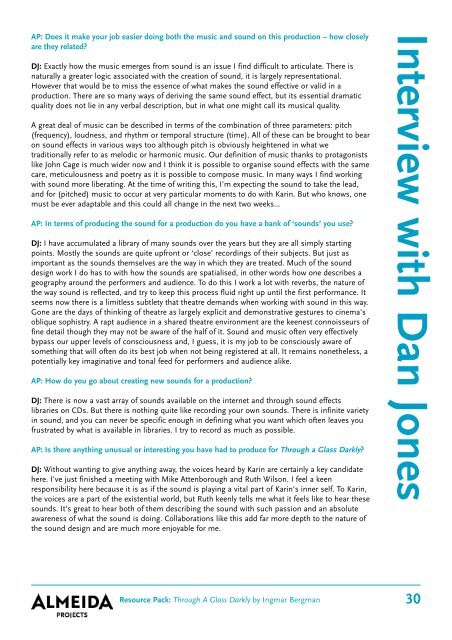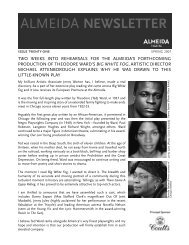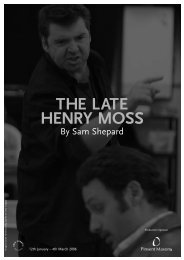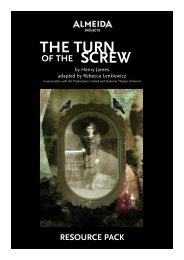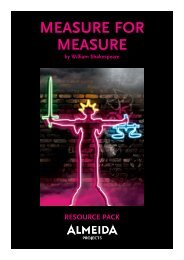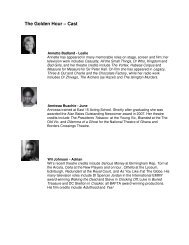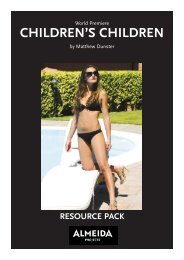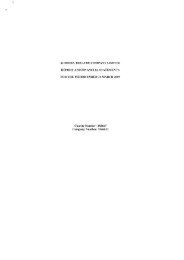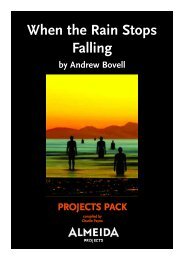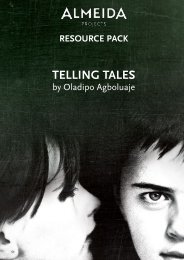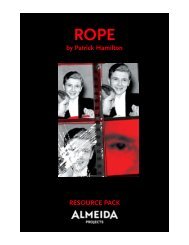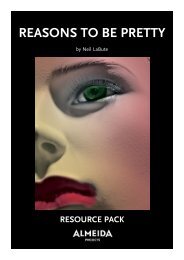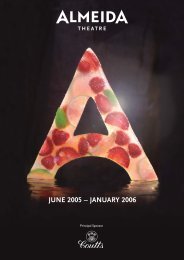Through a Glass Darkly - Almeida Theatre
Through a Glass Darkly - Almeida Theatre
Through a Glass Darkly - Almeida Theatre
- No tags were found...
Create successful ePaper yourself
Turn your PDF publications into a flip-book with our unique Google optimized e-Paper software.
AP: Does it make your job easier doing both the music and sound on this production – how closelyare they related?DJ: Exactly how the music emerges from sound is an issue I find difficult to articulate. There isnaturally a greater logic associated with the creation of sound, it is largely representational.However that would be to miss the essence of what makes the sound effective or valid in aproduction. There are so many ways of deriving the same sound effect, but its essential dramaticquality does not lie in any verbal description, but in what one might call its musical quality.A great deal of music can be described in terms of the combination of three parameters: pitch(frequency), loudness, and rhythm or temporal structure (time). All of these can be brought to bearon sound effects in various ways too although pitch is obviously heightened in what wetraditionally refer to as melodic or harmonic music. Our definition of music thanks to protagonistslike John Cage is much wider now and I think it is possible to organise sound effects with the samecare, meticulousness and poetry as it is possible to compose music. In many ways I find workingwith sound more liberating. At the time of writing this, I'm expecting the sound to take the lead,and for (pitched) music to occur at very particular moments to do with Karin. But who knows, onemust be ever adaptable and this could all change in the next two weeks...AP: In terms of producing the sound for a production do you have a bank of ‘sounds’ you use?DJ: I have accumulated a library of many sounds over the years but they are all simply startingpoints. Mostly the sounds are quite upfront or ‘close’ recordings of their subjects. But just asimportant as the sounds themselves are the way in which they are treated. Much of the sounddesign work I do has to with how the sounds are spatialised, in other words how one describes ageography around the performers and audience. To do this I work a lot with reverbs, the nature ofthe way sound is reflected, and try to keep this process fluid right up until the first performance. Itseems now there is a limitless subtlety that theatre demands when working with sound in this way.Gone are the days of thinking of theatre as largely explicit and demonstrative gestures to cinema'soblique sophistry. A rapt audience in a shared theatre environment are the keenest connoisseurs offine detail though they may not be aware of the half of it. Sound and music often very effectivelybypass our upper levels of consciousness and, I guess, it is my job to be consciously aware ofsomething that will often do its best job when not being registered at all. It remains nonetheless, apotentially key imaginative and tonal feed for performers and audience alike.AP: How do you go about creating new sounds for a production?DJ: There is now a vast array of sounds available on the internet and through sound effectslibraries on CDs. But there is nothing quite like recording your own sounds. There is infinite varietyin sound, and you can never be specific enough in defining what you want which often leaves youfrustrated by what is available in libraries. I try to record as much as possible.AP: Is there anything unusual or interesting you have had to produce for <strong>Through</strong> a <strong>Glass</strong> <strong>Darkly</strong>?DJ: Without wanting to give anything away, the voices heard by Karin are certainly a key candidatehere. I've just finished a meeting with Mike Attenborough and Ruth Wilson. I feel a keenresponsibility here because it is as if the sound is playing a vital part of Karin's inner self. To Karin,the voices are a part of the existential world, but Ruth keenly tells me what it feels like to hear thesesounds. It's great to hear both of them describing the sound with such passion and an absoluteawareness of what the sound is doing. Collaborations like this add far more depth to the nature ofthe sound design and are much more enjoyable for me.Interview with Dan JonesResource Pack: <strong>Through</strong> A <strong>Glass</strong> <strong>Darkly</strong> by Ingmar Bergman 30


